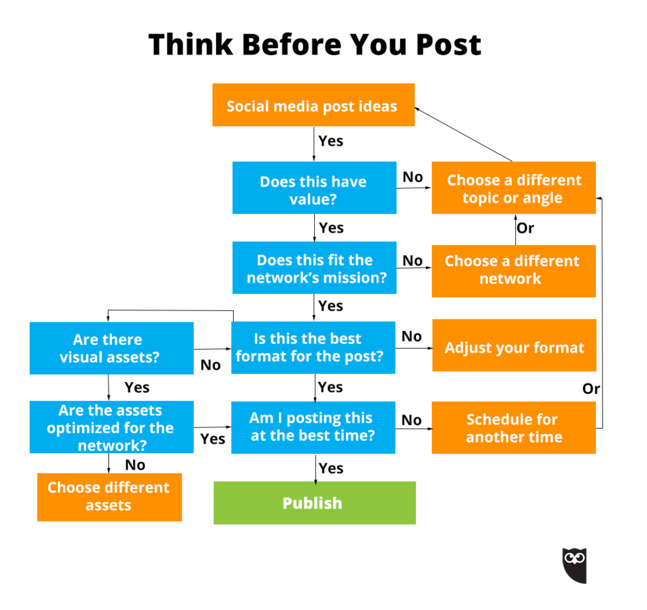Looking for the do’s and don’ts of social media for business owners? You’ve come to the right place. The constant evolution of social media can make it difficult to stay on top of etiquette and best practices for those platforms, especially if you’re an infrequent user. Each social media platform has various nuances that act as unwritten usage rules. When you break one of those rules, you run the risk of looking unprofessional and leaving a negative impression on your audience.
When it comes to social media etiquette for business, behavior and what to do or not do, it takes practice to fully understand how these tips apply to your day-to-day behavior. Here are 25 do’s and don’ts when it comes to social media etiquette for business:
1. DO: Complete and update your social pages and profiles.
First impressions are important and lasting. Think of your social media accounts as your digital first impression. Social media accounts that are only partially completed automatically appear less professional. Take a few minutes to thoughtfully fill out all your profile information, including contact information, and upload good quality profile and cover photos.
2. DO: Separate business and personal.
When building a brand, it helps to keep your personal and professional pages separate on social media. By being consistent with the types of content you share via your business profile, your clients know which account to follow. You also avoid spamming friends and family that follow you for personal updates.
For example, a link to your latest blog post should come from your business page and a video of your dog in the backyard should come from your personal page.
3. DO: Think before you share.
What you post becomes a representation of you and your business. Be proud of who you are and what you represent as a business while staying aware of the image you’re crafting as a result of the content you share. Consider factors like who your audience is, what’s expected on that particular platform, and which content makes you look like an expert.
Use this infographic from HootSuite as a guide if you’re unsure your content is a fit.

4. DO: Post regularly.
This boils down to the big question: how often should you engage with your online community? This can vary depending on your business and industry, but a good rule of thumb is at least once or twice a week. Post too sparsely and you’ll miss opportunities for driving brand awareness, but posting too frequently runs the risk of annoying your followers.
OutboundEngine posts about 2-3 times a week on behalf of customers. This keeps fresh content front and center while freeing up our clients’ time. Clients are able to post on their own and are encouraged to do so.
5. DO: Prioritize your networks.
It may be tempting to try every new social media platform that sprouts up, but it’s dangerous to spread yourself too thin. To start, focus on the social networks where you know your customers are. More than likely, that’s Facebook, LinkedIn, and Instagram, and maybe Twitter. Spend more time improving your presence on those platforms and less on experimenting with new ones, unless you’re sure about where your best prospects spend their time. Providing quality content via the big three networks is worth your time and effort, no matter your industry.
6. DO: Interact with your audience.
Providing helpful content is nice, but it’s not all social media has to offer. Interacting with others is also key.
- See a question or comment on Twitter that you can answer? Send the person a friendly reply.
- Looking for recommendations? Ask your Facebook audience.
- Did someone mention you, tag you, retweet you or share your post? Give them a quick like and a comment!
Build connections online just like you would in person. You don’t have to always be in sales mode; simply having a friendly exchange boosts your legitimacy and gets you exposed to a wider audience, so don’t be afraid to jump in.
7. DON’T: Be needy.
Don’t constantly ask your Twitter followers to “please retweet,” or beg your Facebook friends to “like” your page every week. It’s perfectly acceptable to let your followers on personal accounts know that you have business pages and what they can expect if they follow you. But be strategic. You can still accomplish those tasks, but you’re better off earning them with helpful, shareworthy content.
8. DON’T: Be a spammer.
Retweeting, liking, commenting, posting, and sharing is great, but keep everything in moderation. Nobody wants their social media feeds to be filled by a single account. For example, don’t join 20 groups on LinkedIn and post the same self-promotional message in all of them, and then never interact with members again. Don’t mass-follow random Twitter users in the hopes they will follow you back. Don’t post promotional content in places where self-promotion is not allowed. That’s not the impression you want to leave.
9. DO: Handle criticism gracefully.
Should you run into an issue that causes a flurry of criticism on social media, the worst thing you can do is try and hide from it. Try and respond the best you can, and don’t become defensive. An overreaction to criticism can quickly go viral (in a bad way). Work to remedy the issue and let those who cared about it online know when it’s resolved.
Also read: How to Handle Negative Reviews and Keep the Online Bullies at Bay
10. DON’T: Complain.
All businesses see their ups and downs, but complaining about customer interactions or when a business transaction didn’t go as planned only makes you look unprofessional. Remember, you’re trying to distinguish yourself from competitors. This can be a way to stand out in a less than ideal way. If potential customers see how you talk about others, they may think twice about wanting to do business with you.
11. DO: Help more than you sell.
Who wants their news feed to be constantly full of sales pitches? No one. Though you’re in business to make money, that shouldn’t be the focus of the vast majority of your social media posts. Keep the 80/20 rule in mind here: 80 percent of the content you post or share should be entertaining or informative, while no more than 20 percent of your social media communication should directly relate to the goods or services you provide.
12. DO: Match your content to the platform.
Each social media site has its own intended purpose and audience. Understanding this and matching your content and tone to the proper social media outlet is imperative for success.
Here’s a breakdown:
- Facebook is casual and focused on connections and sub-communities. Don’t be afraid to join relevant groups and engage with others. Keep it friendly!
- LinkedIn’s focus is on business professionals, and the content shared there tends to reflect that. For example, it’s not the best place to share photos of your kids.
- Twitter handles rapid-fire conversation between both businesses and individuals, but the character limit means it’s best for shorter posts.
- Instagram is the perfect place to share something visual, such as a real estate agent’s house listing or a baker’s custom treats.
- If you have video creation skills and some time on your hands, consider trying TikTok and/or YouTube. TikTok focuses on bite-sized, entertaining video content, while YouTube is best for longer-form video. You can give tips related to your industry, answer FAQs, give virtual tours… the sky’s the limit.
13. DO: Watch your grammar and spelling.
The occasional grammar mistake or spelling error isn’t the end of the world, but don’t let it become a pattern. To help avoid mistakes, prep your social media updates in a document or spreadsheet with spell check. You can also ask a colleague to proofread before you share, or use a tool like Grammarly to help you catch more complex mistakes.
Pro tip: Read your post out loud before sharing to catch any missing words or tough-to-understand sentences.
14. DO: Be visual.
Photos and videos can more than double your engagement on social media, so consider adding a relevant image to your text-only posts. If your industry relies heavily on visuals (like real estate or interior design), you may benefit from spending more time on networks with a greater focus on images, like Instagram. But a word of warning: Instagram users tend to favor high-quality photos, so you’ll need to be a competent photographer (or get help from someone who is).
15. DON’T: WRITE IN ALL CAPS.
ARE YOU MAD AT ME? DID I DO SOMETHING WRONG? Stop with the all caps! Not only are they visually alarming, but they also communicate that you’re upset, angry or aggressive. Reserve this style of writing for occasional single-word emphasis, like when something is REALLY important. Always be aware of the tone you’re setting with your words.
16. DO: Location tag other businesses.
Social media is all about sharing. This means supporting favorite restaurants, businesses, and other stops while you’re out and about. Be sure you add your location to your Instagram photo or Facebook status so people know where you were and, more importantly, how they can get there. This is an all-around good move to support other business owners and raise your brand awareness within the community.
17. DON’T: #Abuse #Hashtags
Adding appropriate hashtags connects your post to all other posts on that topic and with that hashtag. It’s a convenient way to categorize and search content on social media networks. That said, don’t turn every word in a post (or a full sentence!) into a hashtag, or stuff unrelated hashtags into your post. When used correctly, hashtags will increase your online visibility and followers. When used in excess, the post looks #spammy and becomes #ineffective. (One more hint: hashtags don’t work in blog posts or emails. Using them that way makes you look unsavvy.)
18. DON’T: Share the exact same message again and again.
Put yourself in the place of your followers. Would you want to read the same message from people or pages you follow every day? It’s lazy and in poor taste to take the same social post and continue to share it over and over again on the same networks. If you want to revisit previous content, get creative with your delivery. Try rewording it or using a new image rather than reposting the same exact thing.
19. DON’T: Share without researching first.
Social media networks make it super easy to quickly share content from another account. With the tidal wave of content and information coming at you at all times, it’s easy to forget that some of this content comes from questionable sources or even bots. Sharing content is often seen as an endorsement of that content and of the user who posted it, so be careful what you share — it could become part of your brand.
Before you click share or retweet, first check out the account that shared the information to be sure you’re comfortable being associated with using them as a source. Many businesses have mistakenly shared information that hadn’t been properly vetted and turned out to be untrue or were shared by a business or person with a shady past.
20. DO: Share without expectations.
Consistency and patience will pay off. Putting time and effort into social media doesn’t mean you’ll see big results right away. You might, and that’s excellent. Similar to starting your business, your reach may be slow at first. Then you’ll make connections, build a reputation, and develop a strategy.
21. DO: Give credit where credit is due.
Stay on the right side of social media etiquette by attributing the author or photographer when you share an interesting article or a gorgeous image. Take the time to find the handle/account responsible for the original post and include it in your post.
Also, be sure to thank those who mention or retweet you. You can make some great connections when you play well with others on social media.
22. DON’T: Automate without thought.
If you’re using the same content across your social channels (and you can!), take the time to change the voice of the message to match the network. Though most social media platforms feature the time-saving option of posting on multiple channels at once, steer clear of it. Take the extra time to write an original message for each social media network based on its intended purpose and audience.
23. DO: Think before tagging.
Tagging others in photos is a great way to introduce your business to their friends, but before you do, think through it. Are you tagging everyone you can think of because you’re hoping some of them will follow you or promote your business? Or are you tagging businesses and people to create a dialogue or to highlight something you admire about them? Unexpected tagging can be a fun way to surprise and delight someone, or it could cost you friends, fans or followers.
24. DON’T: Obsess about the numbers.
It’s important to remember that brand awareness and growing your network is a long-term effort. We know it’s easy to get caught up in the numbers game, but try not to. While having lots of followers can be good, it’s quality over quantity.
If you have 1,000 Twitter followers and half of them are spam accounts, your tweets are being delivered to an audience that doesn’t truly exist. So stress less about your follower count and concentrate on providing engaging content for your audience.
25. DO: Have fun!
Using social media for your business doesn’t mean you should stop having fun with it! Shake things up from time to time. Try live videos or interactive polls and keep your messages friendly and conversational. You’ll see that you can enjoy this part of your business instead of dreading it.
With the social media landscape constantly evolving, the do’s and don’ts of social media etiquette for business owners will also continue to change. Staying aware of current best practices and incorporating them into your social media strategy will keep your marketing efforts fresh and your business top of mind.
Still feeling like it’s too much? We understand. OutboundEngine can take over your social media strategy by posting to professionally written content to your social platforms as well as helping with paid social ads. Just request a demo and a small business consultant will walk you through it one-on-one.


![Better Email Etiquette Equals Better Marketing Results [16 Rules]](https://www.outboundengine.com/wp-content/uploads/shutterstock_411184843-1-400x250.jpg)

